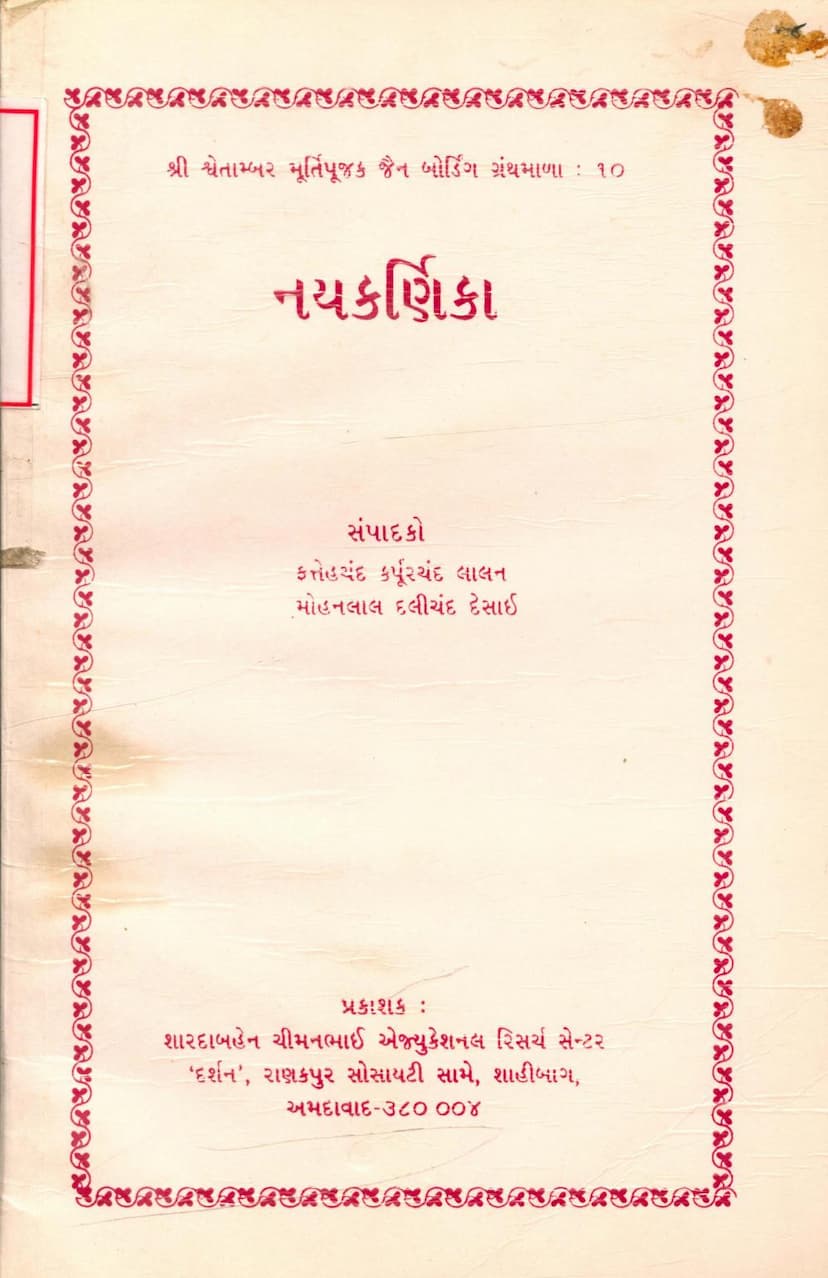Naykarnika
Added to library: September 2, 2025

Summary
Here's a comprehensive summary of the Jain text "Naykarnika" based on the provided pages:
Book Title: Naykarnika Author(s): Fattehchand K Lalan, Mohanlal D Desai Publisher: Shardaben Chimanbhai Educational Research Institute Catalog Link: https://jainqq.org/explore/022466/1
Overview:
"Naykarnika" is a significant Jain text that focuses on the crucial doctrine of "Nay" (or "Naya"). The publishers highlight that understanding the Nay Siddhanta is fundamental to grasping Jain philosophy. This particular work is a concise treatise, composed of 23 verses, originally authored by Upadhyay Vinayvijayji. It aims to elucidate the complex concept of Nay in a simple and accessible manner, serving as an introductory guide for newcomers to Jain logic and philosophy. The book is presented here with an introduction by Fattehchand K. Lalan, who sheds light on Jain philosophy and the life of Upadhyay Vinayvijayji, and a detailed commentary by Mohanlal D. Desai, who critically analyzes the seven Nayas. This edition is a re-publication of a text originally printed in 1910.
Key Concepts Explained:
- The Importance of Nay: Nay Siddhanta is considered the "alphabet" of "Dravyanuyoga" (the branch of Jain literature dealing with substances and reality). It is essentially the science of "apeksha-jnana" (knowledge of relative viewpoints). Jain philosophy posits that every object possesses infinite qualities or characteristics. A Nay is a perspective that emphasizes one or more of these qualities, while acknowledging that other viewpoints also exist. Understanding all Nayas collectively provides a complete knowledge of an object.
- Relativity and Many-Sidedness (Anekantavada/Syadvada): The core of Jain philosophy is Anekantavada (many-sidedness) and Syadvada (the doctrine of conditional predication). This means that reality is relative and can be viewed from multiple perspectives. The text emphasizes that all philosophical schools and religious beliefs are essentially different "apeksha" (viewpoints) on reality. Jainism, through its understanding of Nayas, seeks to synthesize these diverse perspectives.
- The Seven Nayas: The book outlines the seven primary Nayas:
- Naigama Naya: Accepts both general (common) and specific qualities of an object. It acknowledges that both aspects are essential for understanding reality.
- Sangraha Naya: Primarily focuses on the general (common) qualities, viewing specific qualities as secondary or non-existent independently.
- Vyavahara Naya: Primarily focuses on the specific qualities, considering general qualities as less important for practical understanding.
- Riju-sutra Naya: Focuses solely on the present moment and the current state of an object, disregarding the past and future. It is also described as accepting only "bhava-nikshepa" (essence or actual state).
- Shabda Naya: Believes that different words with synonyms refer to the same single object. It accepts the "bhava-nikshepa" and disregards other forms of "nikshepa" (name, establishment, substance).
- Samabhiruḍha Naya: Believes that different words (synonyms) refer to different meanings based on their etymology or inherent nature.
- Evambhuta Naya: Believes that an object should only be called by a name if it is actually performing the action or embodying the quality associated with that name. It is the most refined Naya.
- The Purpose of Nayas: The Nayas are presented as tools for understanding complex philosophical and religious ideas. They help to reconcile seemingly contradictory viewpoints by demonstrating how each perspective is valid from its own relative standpoint. The ultimate goal is to lead the seeker towards the comprehensive understanding of Jain philosophy, which encompasses all Nayas.
- The Analogy of the Blind Men and the Elephant: This classic analogy is used to illustrate the concept of Naya and Nayasabhava (fallacy of perspective). Each blind man, touching a different part of the elephant, forms a limited understanding. Similarly, without understanding all the Nayas, one can fall into "Nayasabhava" by clinging to a single perspective as the absolute truth.
- The Seven Nayas as Stages of Understanding: The text suggests that the Nayas can be viewed as a progression, with each subsequent Naya offering a more refined and comprehensive understanding than the previous one. This progression ultimately leads to the full realization of Jain philosophy.
- Inclusion of Other Philosophies: The authors, particularly Mohanlal D. Desai in his introduction and commentary, suggest that Jain philosophy, through its understanding of Nayas, can embrace and understand other philosophical and religious systems by identifying the "satyanśa" (element of truth) in each. This is presented as a path to universal harmony and understanding.
- Author's Biography (Vinayvijayji): The book includes a detailed biographical section on Upadhyay Vinayvijayji, outlining his known works, his possible birth and death dates, his guru lineage, and his association with other contemporary Jain scholars like Yashovijayji. It highlights his expertise in grammar and his prolific writing.
- Commentary by Mohanlal D. Desai: Desai's "Sphut Vivechan" provides a detailed explanation of each Naya, including its etymology, its core principles, and illustrative examples, often drawing from Jain scriptures and philosophical arguments. He also discusses the classification of Nayas into "Dravyarthika" and "Paryayarthika" and their relationship to "Nishchaya" and "Vyavahara" Nayas.
Structure of the Book:
The book's structure includes:
- Agr Vachan (Foreword): By Fattehchand K. Lalan.
- Upodghat (Introduction): By Mohanlal D. Desai, discussing the broader philosophical context and the importance of Nayas.
- Shri Vinayvijayji: A biographical sketch of the author.
- Sphut Vivechan (Detailed Commentary): By Mohanlal D. Desai, analyzing each Naya.
- Nivedan (Statement): By Mohanlal D. Desai, regarding his contributions to the book.
- Naykarnika: The original text by Upadhyay Vinayvijayji, containing the verses.
- Shri Naykarnika Saradarshit Mahavir Stavan: A summary poem of the Nayas by Ra. Hirachand Sheshkaran Bhanshali.
- Savistar Vishayanukram (Detailed Table of Contents): An extensive index of the topics covered.
Overall Significance:
"Naykarnika" is presented as a foundational text for anyone seeking to understand Jain logic and metaphysics. Its accessibility, coupled with the insightful commentary, makes it a valuable resource for both students and scholars interested in the nuanced philosophical framework of Jainism. The re-publication emphasizes its continued relevance and the need to disseminate its teachings.